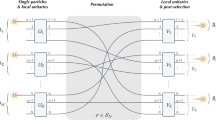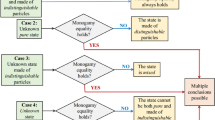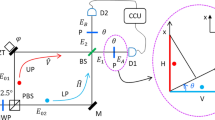Abstract
Quantum theory stipulates that if two particles are identical in all physical aspects, the allowed states describing the system are either symmetric or antisymmetric with respect to permutations of single-particle states1,2,3,4,5. Experimentally, the symmetry of the states can be inferred indirectly from the fact that neglecting the correct exchange symmetry in the theoretical analysis leads to dramatic discrepancies with the observations6,7,8,9,10,11,12,13. The only way to directly unveil the symmetry of the states for, say, two identical particles is through the interference of the state itself and its physically permuted version, and measuring the phase associated with the permutation process, the so-called particle exchange phase14. Following this idea, we have observed the exchange phase of indistinguishable photons, providing direct evidence of their bosonic character.
This is a preview of subscription content, access via your institution
Access options
Access Nature and 54 other Nature Portfolio journals
Get Nature+, our best-value online-access subscription
$29.99 / 30 days
cancel any time
Subscribe to this journal
Receive 12 print issues and online access
$209.00 per year
only $17.42 per issue
Buy this article
- Purchase on Springer Link
- Instant access to full article PDF
Prices may be subject to local taxes which are calculated during checkout



Similar content being viewed by others
Data availability
The authors declare that the main data supporting the findings of this study are available within the article and its Supplementary Information. Extra data are available from the corresponding authors upon reasonable request.
Code availability
The code that was used to analyse the experimental data is available from the corresponding authors upon reasonable request.
References
Leinaas, J. M. & Myrheim, J. On the theory of identical particles. Il Nuovo Cimento B (1971-1996) 37, 1–23 (1977).
Pauli, W. Über den Zusammenhang des Abschlusses der Elektronengruppen im Atom mit der Komplexstruktur der Spektren. Zeitschrift für Physik 31, 765–783 (1925).
Davis, K. B. et al. Bose-Einstein condensation in a gas of sodium atoms. Phys. Rev. Lett. 75, 3969–3973 (1995).
Messiah, A. M. L. & Greenberg, O. W. Symmetrization postulate and its experimental foundation. Phys. Rev. 136, B248–B267 (1964).
Sakurai, J. J. & Napolitano, J. Modern Quantum Mechanics 2nd edn (Cambridge Univ. Press, 2017).
Hilborn, R. C. & Yuca, C. L. Spectroscopic test of the symmetrization postulate for spin-0 nuclei. Phys. Rev. Lett. 76, 2844–2847 (1996).
Modugno, G., Inguscio, M. & Tino, G. M. Search for small violations of the symmetrization postulate for spin-0 particles. Phys. Rev. Lett. 81, 4790–4793 (1998).
English, D., Yashchuk, V. V. & Budker, D. Spectroscopic test of Bose-Einstein statistics for photons. Phys. Rev. Lett. 104, 253604 (2010).
Ramberg, E. & Snow, G. A. Experimental limit on a small violation of the Pauli principle. Phys. Lett. B 238, 438–441 (1990).
de Angelis, M., Gagliardi, G., Gianfrani, L. & Tino, G. M. Test of the symmetrization postulate for spin-0 particles. Phys. Rev. Lett. 76, 2840–2843 (1996).
DeMille, D., Budker, D., Derr, N. & Deveney, E. Search for exchange-antisymmetric two-photon states. Phys. Rev. Lett. 83, 3978–3981 (1999).
Ospelkaus, S. et al. Quantum-state controlled chemical reactions of ultracold potassium-rubidium molecules. Science 327, 853–857 (2010).
Levin, K., Fetter, A. L. & Stamper-Kurn, D. M. Ultracold Bosonic and Fermionic Gases 1st edn (Cambridge Univ. Press, 2012).
Roos, C. F., Alberti, A., Meschede, D., Hauke, P. & Häffner, H. Revealing quantum statistics with a pair of distant atoms. Phys. Rev. Lett. 119, 160401 (2017).
Walmsley, I. Quantum interference beyond the fringe. Science 358, 1001–1002 (2017).
Hong, C. K., Ou, Z. Y. & Mandel, L. Measurement of subpicosecond time intervals between two photons by interference. Phys. Rev. Lett. 59, 2044–2046 (1987).
Perez-Leija, A. et al. Endurance of quantum coherence due to particle indistinguishability in noisy quantum networks. npj Quant. Info. 4, 45 (2018).
Nosrati, F., Castellini, A., Compagno, G. & Lo Franco, R. Robust entanglement preparation against noise by controlling spatial indistinguishability. npj Quant. Info. 6, 39 (2020).
Castellini, A. et al. Indistinguishability-enabled coherence for quantum metrology. Phys. Rev. A 100, 012308 (2019).
Sperling, J., Perez-Leija, A., Busch, K. & Walmsley, I. A. Quantum coherences of indistinguishable particles. Phys. Rev. A 96, 032334 (2017).
LoFranco, R. & Compagno, G. Indistinguishability of elementary systems as a resource for quantum information processing. Phys. Rev. Lett. 120, 240403 (2018).
Morris, B. et al. Entanglement between identical particles is a useful and consistent resource. Phys. Rev. X 10, 041012 (2020).
Sun, K. et al. Experimental quantum entanglement and teleportation by tuning remote spatial indistinguishability of independent photons. Opt. Lett. 45, 6410–6413 (2020).
Barros, M. R. et al. Entangling bosons through particle indistinguishability and spatial overlap. Opt. Express 28, 38083–38092 (2020).
Mirman, R. Experimental meaning of the concept of identical particles. Il Nuovo Cimento B (1971-1996) 18, 110–122 (1973).
Landshoff, P. & Stapp, H. P. Parastatistics and a unified theory of identical particles. Ann. Phys. 45, 72–92 (1967).
van Enk, S. J. Exchanging identical particles and topological quantum computing. Preprint at https://arxiv.org/abs/1810.05208 (2018).
Peres, A. Quantum Theory: Concepts and Methods 1st edn (Springer, 2002).
Aharonov, Y. & Anandan, J. Phase change during a cyclic quantum evolution. Phys. Rev. Lett. 58, 1593–1596 (1987).
Wang, K., Weimann, S., Nolte, S., Perez-Leija, A. & Szameit, A. Measuring the Aharonov-Anandan phase in multiport photonic systems. Opt. Lett. 41, 1889–1892 (2016).
Altschul, B. Testing photons’ Bose-Einstein statistics with Compton scattering. Phys. Rev. D 82, 101703 (2010).
Urban, E. et al. Coherent control of the rotational degree of freedom of a two-ion Coulomb crystal. Phys. Rev. Lett. 123, 133202 (2019).
Matthiesen, C., Yu, Q., Guo, J., Alonso, A. M. & Häffner, H. Trapping electrons in a room-temperature microwave Paul trap. Phys. Rev. X 11, 011019 (2021).
Sinha, U., Couteau, C., Jennewein, T., Laflamme, R. & Weihs, G. Ruling out multi-order interference in quantum mechanics. Science 329, 418–421 (2010).
Acknowledgements
We thank PicoQuant GmbH for providing the MultiHarp 150. C.M. T.K. and O.B. acknowledge support by the German Research Foundation (DFG) Collaborative Research Center (CRC) SFB 787 project C2 and the German Federal Ministry of Education and Research (BMBF) with the project Q.Link.X. Figures 1 and 2 were created with the freely available 3DOptix optical design tool. We thank the 3DOptix-Team, who kindly allowed the use of their software to produce the figures of the article.
Author information
Authors and Affiliations
Contributions
A.P.-L., K.T., O.B. and K.B. initiated the study and guided the work. K.T., C.M., T.K., M.S. and J.W. designed the interferometer. M.S., C.M. and T.K. set up the interferometer. C.M. and M.S. performed the optical measurements. C.M. and K.T. analysed and interpreted the experimental data. K.T. and A.P.-L. developed the theory. K.T., C.M. and A.P.-L. wrote the manuscript with input from all co-authors.
Corresponding authors
Ethics declarations
Competing interests
The authors declare no competing interests.
Additional information
Peer review information Nature Photonics thanks Dmitry Budker and Rosario Lo Franco for their contribution to the peer review of this work.
Publisher’s note Springer Nature remains neutral with regard to jurisdictional claims in published maps and institutional affiliations.
Supplementary information
Supplementary Information
Supplementary Figs. 1–5 and discussion.
Rights and permissions
About this article
Cite this article
Tschernig, K., Müller, C., Smoor, M. et al. Direct observation of the particle exchange phase of photons. Nat. Photon. 15, 671–675 (2021). https://doi.org/10.1038/s41566-021-00818-7
Received:
Accepted:
Published:
Issue Date:
DOI: https://doi.org/10.1038/s41566-021-00818-7
This article is cited by
-
Arbitrary entanglement of three qubits via linear optics
Scientific Reports (2022)
-
Directly proving the bosonic nature of photons
Nature Photonics (2021)



